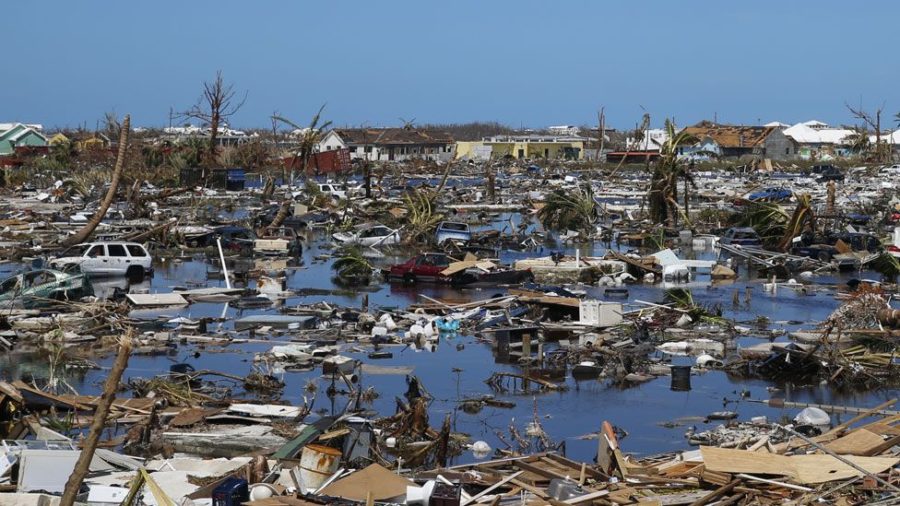Hurricane Dorian’s devastating effects linger
Devastation caused by Hurricane Dorian
October 23, 2019
Hurricane Dorian is the second most powerful Atlantic hurricane ever recorded, and that is no shocking fact given the havoc it wreaked. Dorian came into The Bahamas as a Category 5 storm on Sunday, Sept. 1 and stayed there for upwards of forty hours. With winds of 180 miles per hour, more than forty inches of rain, and massive, 23-foot storm surges, the disaster quickly became the most catastrophic event in the country’s history. But what caused this cataclysm to drag on for as long as it did?
Hurricane Dorian was stuck over The Bahamas due to the loss of its steering currents. Steering winds are just what they sound like: winds that direct storms, which reside in the middle of the atmosphere. Dorian was originally being steered by a high pressure system in the Atlantic, but those winds began to weaken, which is not uncommon. At that point, Hurricane Dorian stalled over The Bahamas.
Stalls of this nature are uncommon but not unprecedented, as other storms such as Florence (2018) and Betsy (1965) experienced the same thing. What was truly unusual about this storm was the concentrated destruction it caused. As stated by Ken Graham, the director of the National Hurricane Center, in an interview with PBS, “I mean you think about the surges of up to twenty-three feet, thirty plus inches of rain, and the winds battering the coastline… it’s an absolutely life-threatening situation”.
And the storm didn’t just destroy lives; it destroyed worlds. The Bahamas will likely never be the same again. Before the storm hit, it was a popular vacation destination known for its clear waters and abundant palm trees. Some of our own Milford High students have visited it and can attest to its former beauty. Laura Nowicki, a junior, used the phrases “beautiful, spotless, and pleasant” to describe the Grand Bahama island. Vanessa West, another junior, who has visited Nassau and Paradise Island, said, “I loved the color of the water and how the buildings were pastel.”
However, few pastel buildings are still standing. The Grand Bahama and Albacos islands, along with most, if not all, of the smaller northern island of The Bahamas, are destroyed. More than 61 people have been confirmed dead, as of October 11th. Of the twenty-one health facilities on the two main islands, nine are operational. More than 13,000 homes have been destroyed, and tens of thousands remain homeless.
It is clear the islands have been decimated, and sadly they will likely remain that way for the foreseeable future.
The Bahamas cannot rebuild like many other countries have done in the wake of hurricanes. After Hurricane Katrina, the United States saw devastation, but also had the funds to reconstruct that which had been destroyed; The Bahamas do not.
The Bahamas have a gross national income of 11.78 billion US dollars. For comparison, the US has a gross national income of 19.61 trillion dollars. This is just one measurement that can be used to show how comparatively poor The Bahamas are and why this disaster can be more easily compared to the earthquake that hit Haiti in 2010 than Hurricane Katrina, which hit the Louisiana area in 2005. It is also worth noting that this GNI will likely decrease, as the major economic activity of The Bahamas was tourism, and no one wants to visit a wasteland.
Although the hurricane is over, destruction and fear live on. An entire country has been reduced to rubble by what one Milford student calls, “The worst natural disaster.” Noelle Fitzgerald, who described hurricanes as such, is a junior who used to live on Merritt Island in Florida. She evacuated her home for Hurricane Irma in 2017.
If people in the US feel the fear of hurricanes, those in The Bahamas must feel overwhelmed by not only the fear of hurricanes, but of the future. They need help, and we at Milford can ease their suffering, even if only by one bottle of clean water. If interested in donating to those in need, visit mercycorps.org, globalgiving.org, bahamasredcross.org, or one of the many other relief organizations who aim to help survivors navigate the future.









